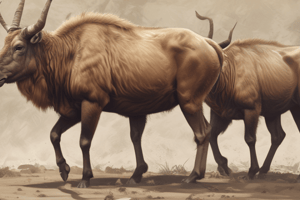Podcast
Questions and Answers
What is mammalogy?
What is mammalogy?
Mammalogy is the branch of zoology that specifically studies mammals.
What are the key features that define mammals?
What are the key features that define mammals?
Mammals are warm-blooded vertebrates that possess hair or fur, mammary glands, three middle ear bones, and neocortexes larger than 1 cubic centimeter.
How do mammologists classify mammals?
How do mammologists classify mammals?
Mammologists classify mammals based on traits such as how they live, where they live, daytime activities, and sensory abilities.
Give examples of how mammals can be classified based on their characteristics.
Give examples of how mammals can be classified based on their characteristics.
Name some notable examples of mammals.
Name some notable examples of mammals.
How have mammals evolved to survive in different environments?
How have mammals evolved to survive in different environments?
Study Notes
Zoology is the branch of biology that studies animals, their characteristics, behavior, and relationships with each other and their environment. One of its primary focus areas within this vast field is mammalogy, which deals specifically with the study of mammals. Mammals are warm-blooded vertebrate animals that possess hair or fur, mammary glands, three middle ear bones, and neocortexes larger than 1 cubic centimeter. They are found throughout the world, from the Arctic Sea ice to tropical rainforests, deserts, and coral reefs, and play important roles in ecosystems ranging from small habitats like ponds and springs to large continental seaboards.
Mammologists classify mammals based on several key traits, including how they live, where they live, what they do during the daytime, and how well they can see or hear things around them. For example, mammals may be classified into groups such as herbivores, carnivores, insectivores, aquatic species, bipeds, and ungulates. Some notable examples of mammals include whales, sharks, dolphins, elephants, elk, porcupines, rabbits, alligators, etc.. These creatures have evolved over millions of years to adapt to various environments and thrive therein, allowing us to learn more about their habits and behaviors through zoological research.
Zoology's role extends beyond mere classification; it also involves studying ecological interactions between organisms, human effects upon wildlife, animal physiology, conservation biology, comparative morphology, taxonomy, systematics, evolutionary biology, genetics, behavior, and population dynamics. By exploring these aspects, scientists better understand how the natural world functions and why certain species exist while others don't, helping to protect endangered species or predict population booms and busts. In essence, mammalogy serves as a fundamental cornerstone of broader studies relating to the interconnectedness of living beings worldwide.
Studying That Suits You
Use AI to generate personalized quizzes and flashcards to suit your learning preferences.
Description
Delve into the fascinating world of mammals through the lens of mammalogy, a key focus area in zoology. Explore the characteristics, behaviors, and relationships of warm-blooded vertebrates with hair or fur, mammary glands, and unique brain features, spanning diverse habitats from Arctic ice to tropical rainforests. Dive into the classification, evolution, and ecological roles of mammals to understand the interconnectedness of life on our planet.




